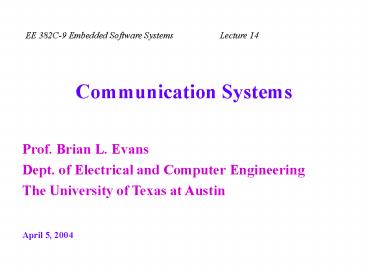Communication Systems PowerPoint PPT Presentation
Title: Communication Systems
1
Communication Systems
April 5, 2004
2
Telephone Touchtone Signal
- Dual-tone multiple frequency (DTMF) signaling
- Sum of a sinusoid fromlow-frequency group
andhigh-frequency group - On for 40-60 ms and offfor rest of signal
interval - Signal interval 100 ms for ATT, 80 ms for ITU
- Keys A-D are for military and radio signaling
applications - Standards
- ATT 10 digits/s maximum dialing rate (40
bits/s) - ITU Q.24 12.5 digits/s maximum dialing rate (50
bits/s)
3
Communication Systems
- Information sources
- Message signal m(t) is information source to be
sent - Possible information sources include voice,
music, images, video, and data, which are
baseband (lowpass) signals - Baseband signals have power concentrated near DC
- Basic structure of analog communication system
shown below
4
Transmitter
- Signal processing
- Conditions message signal
- Lowpass filtering to make sure that the message
signal occupies a specific bandwidth, e.g. in AM
and FM radio, each station is assigned a slot in
the frequency domain. - In a digital communications system, we might add
redundancy to the message bit stream mn to
assist in error detection (and possibly
correction) in the receiver
5
Transmitter
- Carrier circuits
- Convert baseband signal (centered at 0 Hz) into
frequency band appropriate for channel (centered
at carrier frequency) - In FM radio, carrier frequency is radio station
frequency, e.g. 94.7 MHz for Mix FM in Austin, TX - Upconversion uses analog and/or digital
modulation - Analog amplitude modulation would multiply input
baseband signal by sinusoid at the carrier
frequency
6
Channel
- Transmission medium
- Wireline (twisted pair, coaxial, fiber optics)
- Wireless (indoor/air, outdoor/air, underwater,
space) - Propagating signals experience a gradual
degradation over distance - Boosting improves signal and reduces noise, e.g.
repeaters
7
Transmit One Bit
- Transmission over communication channel (e.g.
telephone line) is analog - 2-level digital pulse amplitude modulation
t
Model channel as LTI system with impulse response
h(t)
Assume that Th lt Tb
8
Transmit Two Bits (Interference)
- Transmitting two bits (pulses) back-to-back will
cause overlap (interference) at the receiver - Sample y(t) at Tb, 2 Tb, , andthreshold with
threshold of zero - Change in transmitter to preventintersymbol
interference (ISI)?
A
ThTb
2Tb
t
Tb
Tb
t
-A Th
Assume that Th lt Tb
0 bit
1 bit
0 bit
1 bit
intersymbol interference
9
Transmit Two Bits (No Interference)
- Prevent intersymbol interference by waiting Th
seconds between pulses (called a guard period) - Disadvantages?
1
A
ThTb
Th
Tb
Th
t
t
Assume that Th lt Tb
0 bit
1 bit
10
Wireline Channel Impairments
- Attenuation linear distortion that is dependent
on the frequency response of the channel. - Spreading the finite extent of each transmitted
pulse increases, i.e. pulse widens - Transmit pulse length Ts
- Channel impulse response length Th
- Resulting waveform due to convolution has
duration Ts Th - Phase jitter same sinusoid experiences different
phase shifts in time-varying channel - Additive noise arises from many sources in the
transmitter, channel, and receiver
11
Wireless Channel Impairments
- Same as wireline channel impairments plus others
- Fading multiplicative noise
- Example talking on a cellular phone while
driving a car when the reception fades in and out
- Multiple propagation paths
- Multiple ways for transmitted signal to arrive at
receiver - Simplified channel model for simulation
- Finite impulse response filter plus
- Additive white Gaussian noise
12
Channel Modeling
- Idealchannel
- Simplifiedchannel
- Timevaryingfadingchannel
All blocks are homogeneous synchronous dataflow
Finite impulse response filter
Gaussian noise
Rician random signal
Coefficients
13
Receiver and Information Sinks
- Receiver
- Carrier circuits convert transmission band
(centered at carrier frequency) to baseband
signal (centered at 0 Hz) - Signal processing subsystem extracts and enhances
the baseband signal - Information sinks
- Output devices, e.g. computer screens, speakers,
TV screens
14
Hybrid Communication Systems
- Mixed analog and digital signal processing in the
transmitter and receiver - Example message signal is digital but broadcast
over an analog channel (compressed speech in
digital cell phones) - Signal processing in transmitter
- Signal processing in receiver
Error Correcting Codes
Digital Signaling
A/D Converter
D/A Converter
m(t)
baseband signal
Decoder
Waveform Generator
Equalizer
Detection
A/D
D/A
digitalsequence
digitalsequence
code
15
Amplitude Modulation by Cosine
- Multiplication in time convolution in Fourier
domain of baseband signal f(t) - Sifting property of Dirac delta functional
- Fourier transform
Two copies of F(w)
16
Amplitude Modulation by Cosine
- Example y(t) f(t) cos(wc t)
- f(t) is baseband (lowpass) signal with bandwidth
wm - wm ltlt wc
- Y(w) is real-valued if F(w) is real-valued
- Demodulation modulation then lowpass filtering
- Similar derivation for modulation with sin(wc t)
w
17
Amplitude Modulation by Sine
- Multiplication in time is convolution in Fourier
domain baseband signal f(t) - Sifting property of the Dirac delta functional
- Fourier transform
Two copies of F(w)
18
Amplitude Modulation by Sine
- Example y(t) f(t) sin(w0 t)
- Assume f(t) is an ideal lowpass signal with
bandwidth w1 - Assume w1 ltlt w0
- Y(w) is imaginary-valued if F(w) is real-valued
- Demodulation modulation then lowpass filtering
19
Quadrature Amplitude Modulation
Modulator
cos(2p fc t)
Lowpassfilter
Transmit
I
Bits
Constellation encoder
Bandpass
-
Q
00110
Lowpassfilter
Lookup Tableto give I j Q
sin(2p fc t)
- One carrier
- Single signal
- Occupies all available transmission bandwidth
20
Universal Data Type
- Envelope representation
- Carrier (center) frequency
- Baseband signal
- In-phase component
- Quadrature component
- Time step (sampling period of baseband signal)
- Baseband representation
- Carrier frequency of zero

